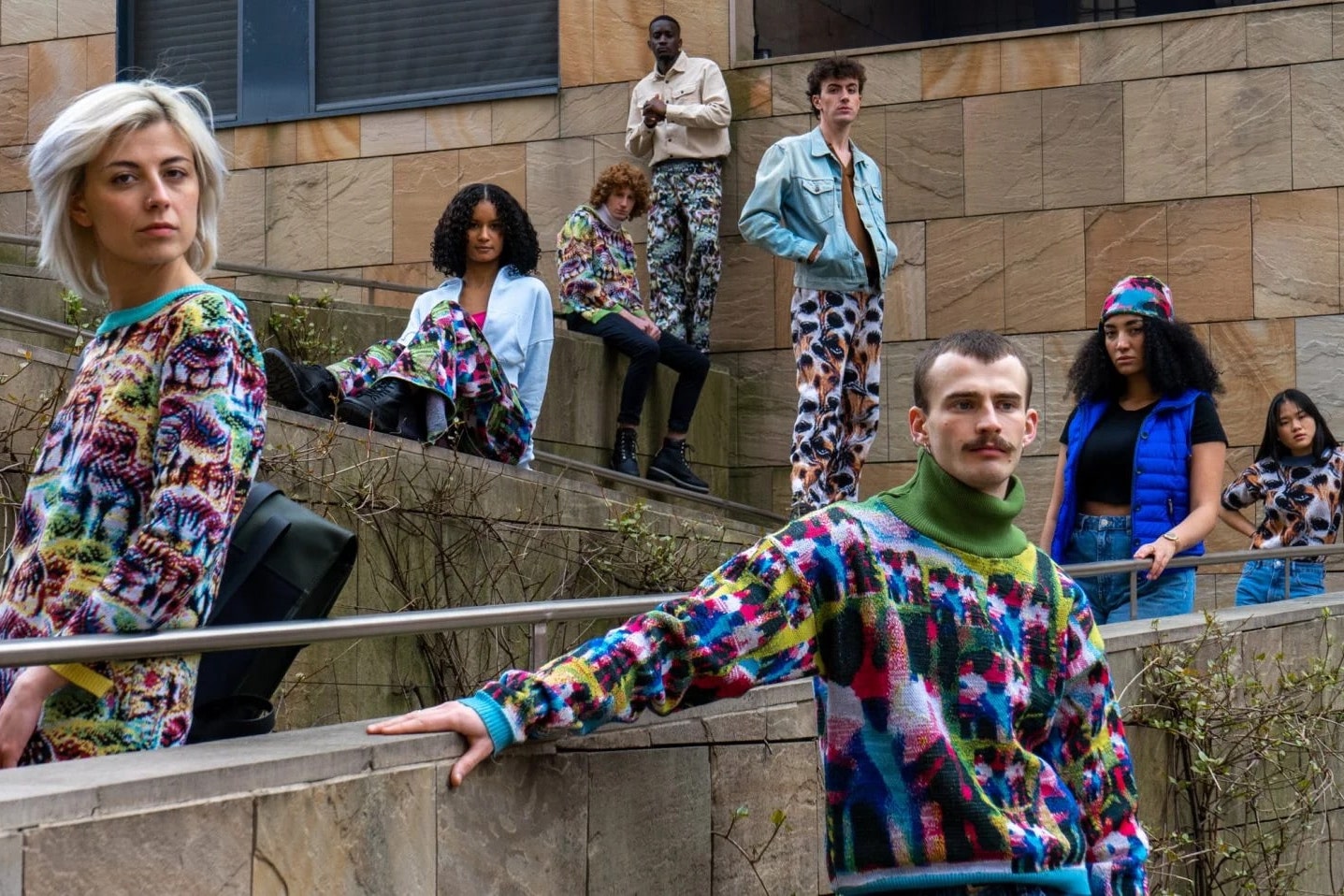Let’s get going.
Not got much time? Take a look at our infographic timeline!

Here are some links to skip to an era of your choice:
The 60s & 70s
The 80s
The 90s
The 00s
The 10s
The 20s
The 60s & 70s
The sustainable fashion movement, and in general the slow fashion movement, has its roots in the 1960s. Up until this time, the movement hadn’t fully formed yet and that’s because the effects of the fashion industry weren’t felt until the 50s when mass production became the norm. That’s when clothing stores became easily accessible and buying clothes was suddenly more convenient than ever before. But the movement emerged along with the global sustainability movement which blew up in the 70s, fuelled by the book Silent Spring but also various grassroots organisations.
 Hippie bus (Photo credit: Junior Libby)
Hippie bus (Photo credit: Junior Libby)
The ‘hippies’ and ‘punks’ were the first groups to introduce sustainable fashion, with the former beginning in the late 60s and the latter beginning in the mid-70s. The ‘hippies’ preferred natural fabrics and a simpler way of life. And the ‘punks’ started rewearing and upcycling clothes, as they preferred secondhand clothing and vintage pieces.
Both groups rejected the dominant idea of traditional fashion and mass consumerism.
The 80s
Beginning in the 70s and building in the 80s, sustainable fashion became a trend thanks to the punk rock movement mentioned before. The scene rebelled against conformity, capitalism, and social institutions and used fashion as a way to express this. As a result, vintage and secondhand shopping and upcycling styles grew among citizens.
 Nisses Nötter, a punk rock band, in 1984. (Photo credit: Sebastian Todor)
Nisses Nötter, a punk rock band, in 1984. (Photo credit: Sebastian Todor)
Then in 1989, Katharine Hamnett - political activist and designer - researched the environmental and social impact of clothing and campaigned on these issues long before they were mainstream. She was the first to wear distressed denim and organic cotton.
The late 80s is also well-known for the anti-fur movement. This commemorated the start of the fight for ethical fashion - which is an important factor in the sustainable fashion movement! These anti-fur campaigns became a part of popular culture in the next decade, with celebrities joining the movement and adding momentum.
But while this era has quite some good, there’s also some bad. This was the time that the demand for fast fashion was increasing. Truly the beginning of the boom for fast fashion. Between this time and the 2000s, outsourcing to poorer countries to take advantage of their lower wages snowballed. Cheap fashion became readily available. While this was - and still is - beneficial for lower income communities, it also meant that there was a surge in worker exploitation.
The 90s
The dichotomy continued, with the fast fashion industry and sustainable fashion both growing despite totally different destinations. The term ‘fast fashion’ emerged in this era, coined by the New York Times to describe Zara’s new accelerated production model - where cheap clothes went rapidly from the design stage to the stores.
But due to the concerning signals of climate change, little by little people made conscious changes to their consumption. People also started to become more aware of social injustice, including the use of sweatshops and child labour. Themes such as this were explored alongside other impacts of globalisation in the book “No Logo” by Naomi Klein.
But in came the rise of purchasing power! And businesses began using sustainability as a selling point. Well-known fashion brands started to take a sustainable path (or invested in more convincing marketing), as sustainability movements started to appear. One of the most notable of these was major brand Esprit who were one of the first to create a vague “eco collection”. Yes, quotation marks. No surprise here - greenwashing was already happening by this time.
Patagonia is a stand-out brand in this era. Yet, they didn’t start off as a sustainable brand. What they did do is evaluate their environmental footprint as a company, and then built on that to become the first outdoor clothing company to transform plastic into fleece. And then in 1996, they became one of the first brands to exclusively use organic cotton.
And then there was People Tree, founded in 1991 - a pioneer brand in sustainable fashion because instead of answering to the growing concerns of sustainability, it was created intentionally with people and the environment in mind. Hence, the name!
The 00s
Fast fashion brands rocketed off, still competing with the cultural shift towards ethical and sustainable fashion which the internet sped up. Bigger brands threw smaller, independent brands off the bandwagon as they couldn’t compete. This was the time when fast fashion became trendy.
At the same time, there was a rising awareness for fair working conditions and sustainability in fashion. Environmentalists were not just considered “tree-hugging hippies” anymore. The conversation shifted, and the fashion industry was impacted so drastically that the term ‘slow fashion’ was coined in 2007 by author and activist Kate Fletcher.
The 10s
To give a little perspective of how globalised fashion became between these eras: until the 60s, the USA was still making 95% of its clothes. By 2015, the USA was only making 5% of its clothing.
Only in 2013 did the majority of people realise how problematic the fashion industry had become, after 1,000 people lost their lives in the Rana Plaza factory collapse in Bangladesh. This major event resulted in a renewed shift in mindset towards sustainable fashion - although there were other tragic events that had happened prior to this. The fashion industry’s ills became embedded in the collective consciousness. Books and films, such as the documentary The True Cost, further exposed fashion’s secrets.
Watch The True Cost here.
Buyers became more informed about brands’ actions and values. To compensate, even high street and luxury brands started to release “eco” collections and other sustainable initiatives.
And to the contrary, many brands were founded in this era with sustainability engraved in their brand identity and mission, such as Will’s Vegan Store.
The 20s - Now
Now in the 2020s, consumers demand transparency from brands. More and more people are changing the way they consume fashion for the better. Whether that’s giving up fast fashion completely, or purchasing more items second hand or vintage, or purchasing from sustainable brands. In 2021, 42% of millennials and Gen Zers stated that they were likely to buy secondhand clothing. And around 1/5th of UK consumers stated that they bought clothes from sustainable brands.
There’s also an unfathomable explosion of sustainable brands. This also means there’s a higher demand than ever for authentic sustainability. Now, we can pick and choose, and be more critical than ever before.
Although, despite all this good news, there’s still a long way to go. We’re trying to be a part of that change. Here at POMP, founded in 2019, we make clothing from certified organic cotton. Only that. Not a single bit of any other material. Biodegradable, natural, and toxic-free. We also recycle old clothing into new, closing the loop as circularity is now a major theme in today’s era. The best part is that we’ve found ways to be affordable, which is a harder box to tick for sustainable brands - since the price for what it costs to treat workers and the planet kindly just has to be higher. If sustainable fashion is going to become a less elitist part of the future timeline, then more brands will have to join us.
We've also covered this topic over on our Instagram, skip on over there for slideshows and posts on all sorts of sustainable fashion topics.





